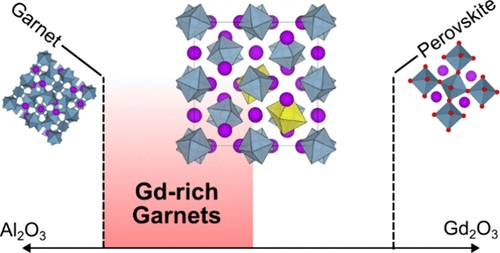Ask for a reprint
email :
* Give your email
2024
ACL
|
X.Fang, V.Castaing, A.I.Becerro, W.Cao, E.Veron, D.Zanghi, M.S.Dyer, C.Genevois, M.Allix, M.J.Pitcher, 'Realization of Extreme Nonstoichiometry in Gadolinium Aluminate Garnets by Glass Crystallization Synthesis', Chem. Mat. 36 8555 (2024) doi:10.1021/acs.chemmater.4c02266
The garnet aluminates RE3Al5O12 (RE = Gd − Lu, Y) are an
important class of optical materials with a range of applications. Typically, they do
not tolerate large deviations from ideal stoichiometry, and their luminescence
properties are controlled by dopant selection rather than modification of the host
structure. Here, we use glass crystallization as a nonequilibrium synthesis route to a
new family of highly nonstoichiometric gadolinium aluminate garnets, of formula
Gd3+xAl5‑xO12 with x ≤ 0.60. Remarkably, this range is much broader than the
previously reported Y3+xAl5‑xO12 series (x ≤ 0.4), despite the vast size contrast
between Al3+ and Gd3+, which are forced to share a crystallographic site in the
nonstoichiometric materials: the endmember Gd3.6Al4.4O12 lies halfway between ideal garnet and perovskite stoichiometries, with
30% of its octahedral Al3+ sites substituted by Gd3+. In principle, this crystal chemistry should allow the synthesis of phosphor
systems with rare-earth activators distributed over two different cation sublattices. To probe the response of luminescence properties
to extreme nonstoichiometry in Gd3+xAl5‑xO12, we synthesized three model phosphor systems by doping with Ce3+, Tb3+, or Tm3+/
Yb3+ and found that upconversion (Tm3+/Yb3+) phosphors have the most potential to be tuned by this approach. These results
demonstrate that highly nonstoichiometric garnet aluminates are not limited to small rare-earth hosts such as YAG, opening new
opportunities for development of different garnet-based optical and magnetic materials.
|

|